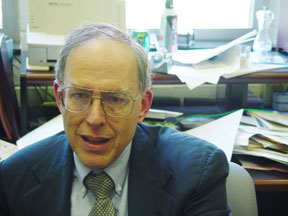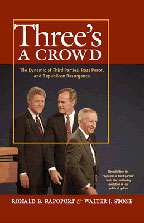Q&A with Rapoport: The validity of Perot and third parties
 Ron Rapoport’s long research career has resulted in a book that details the impact of third parties on U.S. politics, Three’s a Crowd: The Dynamic of Third Parties, Ross Perot, and Republican Resurgence.
Rapoport, John Marshall Professor of Government and department chair at
the College, wrote the book with Walter J. Stone, a professor at the
University of California, Davis. Rapoport studied campaign volunteers
for Ross Perot for nearly 15 years and examined the impact that their
involvement in Perot’s grass-roots campaigns had on their long-term
political engagement as well as the effect of the Perot movement as a
whole on the Republican takeover of Congress and the presidency.
Ron Rapoport’s long research career has resulted in a book that details the impact of third parties on U.S. politics, Three’s a Crowd: The Dynamic of Third Parties, Ross Perot, and Republican Resurgence.
Rapoport, John Marshall Professor of Government and department chair at
the College, wrote the book with Walter J. Stone, a professor at the
University of California, Davis. Rapoport studied campaign volunteers
for Ross Perot for nearly 15 years and examined the impact that their
involvement in Perot’s grass-roots campaigns had on their long-term
political engagement as well as the effect of the Perot movement as a
whole on the Republican takeover of Congress and the presidency.
Rapoport contends that third parties “have their effect, not by appealing to the political middle. Their real impact on the political system stems from their ability to identify important issues that the major parties are ignoring. In so doing, they force the major parties to deal with these new issues. It is in this way, we think, the third parties change the whole party system, by changing the issue agenda of one or both of the major parties.”
Three’s a Crowd explains what Rapoport calls the “dynamic of third parties,” the way that third parties identify issues overlooked by the major parties to attract significant numbers of voters. The book examines this dynamic and the ways in which the major parties respond. Excerpts from an interview with Rapoport appear below.
 Q: Why is Three’s a Crowd important?
Q: Why is Three’s a Crowd important?
Rapoport: The
focus really is in telling how third parties are an engine for
important change in American politics. The Perot movement is a great
example that we were able to study in detail to basically support our
theory. It is not only that Perot people were much more active for the
Republicans in 1994 than they had been, but the more they did for
Perot, the more they did in 1996, 1998 and 2000.
These people are distinct from Democrats and Republicans even though they are within the Republican Party. … This group is different from other Republicans, so in a sense our argument is that this is a group that is still there; it is a group that is up for grabs and that will really determine the short-term future of American politics.
Q: What makes third parties successful?
Rapoport: Third
parties are successful because they identify a distinctive issue
constituency that the major parties have ignored. That then gives a cue
and an incentive for the major parties to try to recapture that
constituency.
Q: Is that why they do not usually last long?
Rapoport:
There is a great line from Richard Hofstadter: “Third parties are like
bees, once they’ve stung they die.” The reason the Perot movement
didn’t die was because, first of all, Perot stayed around. He, unlike
most third-party candidates, didn’t have a place to go in the party,
and so he remained around.
Q: How important are third-party issues?
Rapoport: They can
be too extreme, like Ralph Nader. Nader is issue-specific, but he is so
extreme that for a party to move to his position would be to abandon
people in the center. What Perot did was to identify three sets of
issues. He was not out of the center; he was in a different dimension.
He was identifying issues that were being ignored. … The Perot
dimension was reform, the budget and economic nationalism. So both
parties really were for the North American Free Trade Agreement, but
not Perot. Neither party was willing to engage the budget deficit, but
Perot was. He could absolutely talk about the issues. He was willing to
say you need to raise taxes. The gasoline tax he was big for. He was
willing to take what were perceived as unpopular positions.
Those three issues are where you get the major parties close together,
and that allows a third party to step in and say, “These guys are over
there, I’m over here.” When they are close together and when
significant parts of the public are fairly far apart from them, that is
[when third parties step in].
To give an example, in the 1840s and 1850s neither the Whigs nor the Democrats wanted to take a strong stance on slavery because they would suffer by alienating a significant part of their constituency. The Republicans came in with a strong stance on slavery—that was the new-issue dimension … .
I think a lot of people see the reform party and the Perot movement as being this centrist group. It was not. They were fairly liberal on some issues like abortion; they were fairly conservative on some issues like affirmative action. If you average it together, they looked as if they were in the middle, but they weren’t.
The real appeal is not the center but the new issues. It is in this way we think third parties change the whole party system because they introduce issues that the major parties are ignoring and force the major parties to deal with them. We also think, and we have some evidence on this, that they remain a lumpy group within the party to which they go, but they are not fully integrated into that party.
To go back to the integrity of this constituency, what we found, for instance, is that the more people did for Perot in 1992, the more they did for John McCain in 2000. So eight years later there was still an effect of this Perot constituency that a candidate within a party, like McCain, can appeal to. …
Q: Whom did you interview during your research?
Rapoport:
The Perot campaign gave us a sample of 2,000 people who had called
Perot’s 800-number, and we followed and surveyed them. In ’96, the
campaign gave us a list of people who had contributed money to the
Reform Party … . So we have been able to follow those people. The
problem is that we’ve got 12 years of surveys, but you lose a lot of
people, as you can imagine. Through 2000 the survey was pretty
accurate, even though it had gotten smaller. By 2004 it really was too
small.
We wanted to see what the long-term impact was. We found that the more active you were for Perot in 1992, the more active you were for the Republican candidates in 2000. Eight years later there was still a carry-over effect … . So, looking at how active people were before Perot entered the scene, they were more active for the Republicans. …
Q: Are these people still up for grabs?
Rapoport: I don’t
think anyone can say [that the Perot group] is a significant group that
is up for grabs. In 2004, the more Perot people were contacted by
Republicans, the more they went Republican. The more they were
contacted by Democrats, the more they went Democratic, and to a greater
degree. Democratic contact had a greater impact. I think there was an
inclination to shift. We are looking at the change from 2000 to 2004,
because it was during this period that the Republican Party sort of
pulled back from commitments under Bush. What you find is that the more
you did for Perot, the more you did for the Democrats if the Democrats
called you, but the Democrats did not call on the Perot people as much
as the Republicans did, so it was a lost opportunity.
Q: Did Howard Dean do for Democrats in 2002 what Perot did for Republicans?
Rapoport:
I think what Dean did is similar. Dean identified a distinctive issue
constituency in the Democratic Party, and that was the anti-war group.
He showed that by campaigning on anti-war he could become a powerful
candidate. What happened then was that John Kerry and everyone else
moved to that position. So, Dean did in some ways what Perot did. He
showed a constituency that was not being met, that if a candidate was
not cautious on Iraq he was going to get a lot of voters.
The Dean campaign was an incredibly innovative campaign. It was the best campaign of the year. What it lacked was a candidate. Dean was just not a great candidate, but his campaign was the most creative, innovative campaign.
Q: Do you see a potential third party candidate for 2008?
Rapoport: John McCain could become one, but I think he will probably run on the Republican side.
It is always hard to know [when the time may be right for a third-party candidate because you need the right person. You need an issue constituency, but you need a person to mobilize it. I think if the Democrats [were to support] Hillary Clinton, you could conceive of situations where there would be space for a third party.
I don’t know [whether she will run]. I would think she would run. I don’t think it is absolutely certain she will win the nomination. … [Right now] she has a very high negative—something like 40 percent of people say they would not vote for her. That is a lot to overcome, because that leaves only 60 percent of the people for her to work with. She would need to win 85 percent of them. That’s tough. Now there are a lot of people who say they would vote for her no matter what, so she is a polarizing force. … As we move to 2008, she may well be positioning herself as the centrist candidate rather than the most liberal candidate. I think that’s her goal. I think she will always have a lot of appeal on the left no matter what she is doing. I think her problem is in the center.
 Skip to main content
Skip to main content
